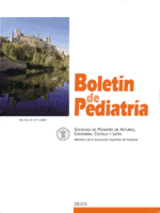Afasia epiléptica adquirida (síndrome de Landau-Kleffner)
S. Fernández Uribe , F. Villanueva Gómez , J. de Juan Frigola , Mª.C. Fernández Miranda , B. Lozano Aragoneses , J.L. Herranz Fernández
Bol. Pediatr. 2001; 41 (177): 195 - 200
Se describe el caso clínico de una niña de 5 años con ausencia total del lenguaje, hiperactividad y crisis paroxísticas compatibles con crisis epilépticas parciales complejas con automatismos orofaríngeos. En el EEG de vigilia se constataron puntas y complejos punta-onda bifrontales y, en el video-EEG durante sueño fisiológico, se objetivó actividad continua generalizada de complejos punta-onda, especialmente durante el sueño lento (fases III-IV), confirmando el diagnóstico de afasia epiléptica adquirida. En este síndrome se asocian la agnosia auditiva verbal y la epilepsia, confirmándose el diagnóstico con el hallazgo en el EEG de punta-onda continua durante más del 80% del sueño lento. La evolución es desfavorable, porque se asocian graves trastornos de la conducta y afectación cognitiva, y por la resistencia de este cuadro electroclínico a todo tipo de terapias. El interés de este caso clínico reside en confirmar la remisión espectacular de sus síntomas al asociar valproato y etosuximida, pauta terapéutica descrita por nosotros anteriormente. Abstract The clinical case of a 5 year old girl with total absence of language, hyperactivity and paroxystic episodes compatible with partial complex epileptic seizures with oropharyngeal utomatism is described. In the wakefulness EEG spikes and bifrontal spike-wave complexes are observed and in the EEG video, during physiological sleep, generalized continuous activity of the spike-wave complex is observed, especially during slow sleep (phases III-IV), confirming the diagnosis of acquired epileptic aphasia. In this syndrome, verbal auditory agnosia and epilepsy are associated, the diagnosis being confirmed with the finding of continuous spike-wave in the EEG during more than 80% of the slow sleep. The evolution is unfavorable, because serious behavior disorders and cognitive involvement are associated and due to the resistance of this electroclinical picture to all types of treatment. The interest of this clinical case is found in the confirmation of the spectacular remission of her symptoms when valproate and etosuximide were combined, a therapeutic regime that we have previously described.
\N
\N
Artículo completo (PDF) (187 kb.)
- Neurología
Buscar en el boletín
Año 2001, Volumen 41, Número 177

Boletín completo en PDF (0 kb.)
En esta edición...
- Editorial (1 artículos)
- Ayuda a la investigación de la Fundación Sánchez Villares (1 artículos)
- Originales (3 artículos)
- Revisiones (2 artículos)
- Casos clínicos (1 artículos)
- Reunión de Primavera (6 artículos)
- IV Curso de Excelencia (9 artículos)
- Pediatría e Internet (1 artículos)
- Noticiario (1 artículos)